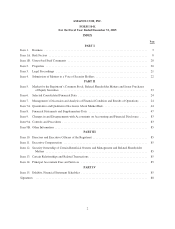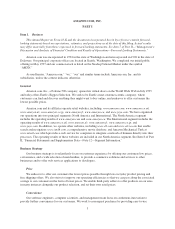Amazon.com 2005 Annual Report Download - page 20
Download and view the complete annual report
Please find page 20 of the 2005 Amazon.com annual report below. You can navigate through the pages in the report by either clicking on the pages listed below, or by using the keyword search tool below to find specific information within the annual report.and control of its business, it might be unable to continue to operate the business. In addition, Joyo.com is subject
to many of the risks described in “Our Business Could Suffer if We are Unsuccessful in Making, Integrating, and
Maintaining Acquisitions and Investments.”
If We Do Not Successfully Optimize and Operate Our Fulfillment Centers, Our Business Could Be Harmed
If we do not successfully operate our fulfillment centers, it could significantly limit our ability to meet
customer demand. Because it is difficult to predict demand, we may not manage our facilities in an optimal way,
which may result in excess or insufficient inventory or warehousing, fulfillment, and distribution capacity. A
failure to optimize inventory in our fulfillment network will increase our net shipping cost by requiring us to
make long-zone shipments or partial shipments from one or more locations. Orders from several of our
internationally-focused websites are fulfilled primarily from a single fulfillment center, and we have only a
limited ability to reroute orders to third parties for drop-shipping. We and our co-sourcers may be unable to
adequately staff our fulfillment and customer service centers. As we continue to add fulfillment and warehouse
capability or add new businesses with different fulfillment requirements, our fulfillment network becomes
increasingly complex and operating it becomes more challenging. There can be no assurance that we will be able
to operate our network effectively.
We rely on a limited number of shipping companies to deliver inventory to our fulfillment centers and
completed orders to our customers. If we are not able to negotiate acceptable terms with these companies or they
experience performance problems or other difficulties, it could negatively impact our operating results and
customer experience. In addition, our ability to receive inbound inventory efficiently and ship completed orders
to customers also may be negatively affected by inclement weather, fire, flood, power loss, earthquakes, labor
disputes, acts of war or terrorism, acts of God and similar factors.
Third parties either drop-ship or otherwise fulfill an increasing portion of our customers’ orders, and we are
increasingly reliant on the reliability, quality, and future procurement of their services. Under some of our
commercial agreements, we maintain the inventory of other companies in our fulfillment centers, thereby
increasing the complexity of tracking inventory in and operating our fulfillment centers. Our failure to properly
handle such inventory or the inability or failure of these other companies to accurately forecast product demand
would result in unexpected costs and other harm to our business and reputation.
The Seasonality of Our Business Places Increased Strain on Our Operations
We expect a disproportionate amount of our net sales to be realized during the fourth quarter of our fiscal
year. If we do not stock popular products in sufficient amounts or fail to have sources to timely restock popular
products, such that we fail to meet customer demand, it could significantly affect our revenue and our future
growth. If we overstock products, we may be required to take significant inventory markdowns or write-offs,
which could reduce gross profits. A failure to optimize inventory in our fulfillment network will harm our
shipping margins by requiring us to make long-zone shipments or partial shipments from one or more locations.
Orders from several of our internationally-focused websites are fulfilled primarily from a single fulfillment
center, and we have only a limited ability to reroute orders to third parties for drop-shipping. We may experience
an increase in our net shipping cost due to complimentary upgrades, split-shipments, and additional long-zone
shipments necessary to ensure timely delivery, especially for the holiday season. If the other businesses on whose
behalf we perform inventory fulfillment services deliver product to our fulfillment centers in excess of forecasts,
we may be unable to secure sufficient storage space and may be unable to optimize our fulfillment centers. If too
many customers access our websites within a short period of time due to increased holiday or other demand, we
may experience system interruptions that make our websites unavailable or prevent us from efficiently fulfilling
orders, which may reduce the volume of goods we sell and the attractiveness of our products and services. In
addition, we may be unable to adequately staff our fulfillment centers during these peak periods and third parties
that provide fulfillment services to our customers may be unable to meet the seasonal demand. Finally, we, along
with our customer service co-sourcers, may be unable to adequately staff customer service centers.
12
























